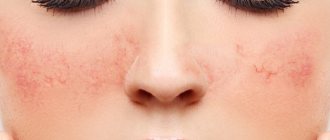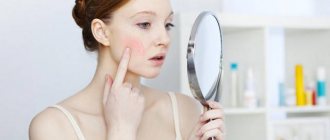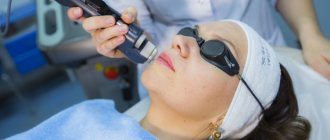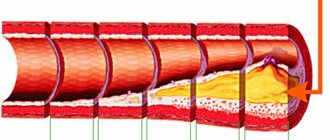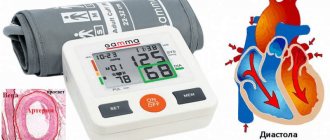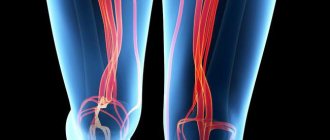Human skin in any area is literally permeated with small vessels that are normally not visible outwardly. And the health of the skin also depends on these vessels, which bring it nutrition and oxygen. But if their work fails, this is immediately reflected in the condition of the skin. Another manifestation is that the vessels themselves begin to protrude to the surface and become visible - the veins appear on the face. Usually due to the expansion of capillaries in the form of a network of vessels and spider veins, called telangiectasia. These manifestations are collectively called rosacea or varicose veins on the face.
The essence of pathology
Cuperosis (rosacea of an unspecified type) thus refers to pathologies with impaired blood microcirculation due to increased fragility and dilation of capillaries. This happens due to a violation of the elasticity of the blood vessels, and their wear resistance is lost. Negative factors can narrow and expand capillaries. But the property of narrowing is quickly lost and vasodilation remains. They do not have time to pump blood. This is often accompanied by blockage. It looks like red dots with convoluted lines of capillaries extending from them. Their thickness does not exceed 1 mm, the color is red and violet-red.
Stars are a very precise name for formations on non-inflamed skin. They are especially often and clearly visible on the cheeks and wings of the nose. More often, this pathology is typical for women, especially after 30 years. They pay more attention to their appearance, perhaps this explains the frequency.
Why are veins visible on the face? Not only does the vessel wall lose its elasticity, but the skin also becomes thinner with age or for various reasons. Therefore, the veins become noticeable, appearing through them. This phenomenon occurs not only on the face, but also on the skin of the entire head and neck. Of course, it makes few people happy.
So, the reason for the veins on the face and the appearance of rosacea is dilated capillaries. The pathology begins with the smallest caliber of vessels, but if left untreated, others are also affected. Knot-like protruding formations appear. Varicose veins on the face do not pose any particular harm, but the aesthetic defect gives rise to psychological problems.
Symptoms of the disease
Varicose veins on the face most often appear after 35 years; women are at risk, since their skin is highly sensitive. When the first symptoms of the disease appear, you should immediately seek treatment from a doctor. Lack of timely treatment can lead to disruption of tissue nutrition, slowdown of metabolic processes, and acceleration of the aging process.
Stages
The disease goes through several stages; dermatologists identify the following manifestations of rosacea at different stages:
- Stage 1 - the pathology does not manifest itself in any way, slight redness may periodically appear on the skin, which passes over time, the vascular walls return to their original state after expansion, this property is lost as the disease progresses;
- Stage 2 - spider veins in the form of veins or meshes, vascular nodules, and vascular nodules are clearly visible on the skin; in the photo you can see different localization options;
- Stage 3 - accompanied by the development of inflammation and microcirculation disorders, as a result, the aging process accelerates and complexion deteriorates.
What is a spider vein?
Telangiectasia is a persistent dilatation of blood vessels in the skin or mucous membranes, which is non-inflammatory in nature. Asterisks arise from arterioles, capillaries and/or venules. Due to the lack of consequences, it is rather a symptom and it may accompany some pathologies.
Couperosis can occur on almost any part of the body: face, lips, eyes, tongue, buttocks, legs, stomach, etc. The most common location is on the face: on the cheeks, wings of the nose, under the eyes. Stars on the skin may appear and disappear after some time. But over time they become brighter and expand.
Types and causes of nosebleeds
Bleeding from the nasal passages is divided into two categories.
Anterior, occur due to damage to the blood capillaries located in the anterior sections of the nasal cavity (Kiesselbach-Little area). The bleeding is not profuse, the blood comes out of the nostrils, ends quickly, and does not require medical intervention.
Posterior - localized in the deep parts of the nasal passages. Larger vessels are damaged. Blood flows down the back wall of the throat in copious streams. The bleeding is intense, protracted and requires medical intervention.
There may be several reasons why blood flows from the sinuses. They are divided into local and general. Common reasons include:
- A blood disease in which blood clotting is impaired, anemia, thrombocytopenia, hemophilia.
- High blood pressure due to hypertension , heart defects. Vascular atherosclerosis, covering the vessels of the nasal cavity.
- Tiring physical activity , sleep problems, frequent stress, poor nutrition.
- Increased body temperature associated with infectious diseases.
- Chronic sinusitis, sinusitis, rhinitis, inflammation of the adenoids.
- Hormonal imbalance during pregnancy or due to age-related changes.
- Liver diseases, allergic reactions accompanied by rhinitis.
Local reasons include:
- drying of the nasal mucosa;
- mechanical damage, injuries;
- presence of a foreign body;
- deformation of the nasal septum;
- tumor formations in the sinuses.
Perhaps nosebleeds are not an independent phenomenon, but an indirect symptom of a more serious disease. But whatever the reason, it is necessary to treat weak vessels in the nose.
Attention. If, upon reaching reproductive age, the blood vessels remain brittle, it is necessary to take measures to strengthen them.
Factors of occurrence
Why did veins appear on the face? The reason may be:
- liver diseases;
- heart diseases;
- gastrointestinal pathologies;
- hypertonic disease;
- anemia;
- dehydration of the body;
- circulatory disorders.
- varicose veins can appear suddenly, especially after sun exposure or visits to solariums;
- frostbite;
- constant lack of sleep;
- age-related changes;
- poor heredity with congenital vascular pathology;
- dry facial skin;
- excessive stress on the skin of the face due to allergic frequent sneezing;
- use of low-quality cosmetics;
- alcohol abuse (especially red wine);
- smoking;
- spicy food, coffee, chocolate;
- imbalance of hormones during pregnancy, menopause (hormones are disrupted even during the menstrual cycle!);
- the use of hard peelings;
- long-term use of COCs;
- use of glucocorticosteroids;
- working with body overheating or hypothermia;
- hard physical labor.
Those with fair skin are especially susceptible to varicose veins.
Causes
The essence of the pathology is that due to excessive blood flow into the capillaries of the face, they become noticeable against the background of the skin. They can also protrude into the inner cavity of the nose, causing bleeding.
The main reason is hereditary predisposition, as well as hormonal imbalances in the body, which can be triggered by various factors.
Common precipitating circumstances include:
- excessive physical activity, long work;
- increased body weight;
- bad habits (smoking, alcohol abuse);
- incorrect selection of cosmetics. In this case, rosacea manifests itself more like an allergic reaction to bad cosmetics;
- increased amount of ultraviolet radiation, which affects the skin of the face (staying in the sun or in a solarium);
- exposure to negative substances on the nasal mucosa (evaporation of harmful products);
- prolonged exposure to aggressive weather conditions on the body.
Also, often similar characteristic symptoms arise as a result of certain pathologies: VSD, hypertension, gastrointestinal problems, dysbacteriosis, venous insufficiency.
Symptomatic manifestations
Symptoms of the disease depend on the stage:
- On the first wall, the capillaries are still capable of contracting. For no apparent reason, mild redness of the face appears, which goes away after some time. Later, the veins expand more and lose their ability to contract.
- At the second stage, spider veins appear. A photo of the veins on the face is shown below. Telangiectasias are often accompanied by itching. The vessels are irreducible, they rupture and subcutaneous pinpoint hemorrhage is formed. Later, under the eyes and on the cheekbones, a mesh of a bluish color appears - it is formed by veins. Here the diameter can already reach 3 mm. Such disorders do not disappear by themselves, since the venous system is closed.
- The last stage of rosacea is dilated veins protruding to the surface. Microcirculation is chronically impaired, the expansion of blood vessels is not controlled and they swell. Lumpy areas are visible on the face.
Danger of disease
Not only nosebleeds due to burst blood vessels can be caused by rosacea. Also, against the background of this pathology, the color of the facial skin deteriorates, its tone decreases, which causes the appearance of wrinkles and sagging. Possible complications, in the absence of proper treatment, manifest themselves in the fact that breathing through the nose becomes noticeably more difficult. With frequent nosebleeds, thrombosis of these capillaries may develop, as well as stagnation of the maxillary cavities and suppuration.
In addition, do not forget that any vascular pathology has its own underlying causes. If they are not eliminated completely, then further deterioration of the condition and damage to more and more vascular walls is possible.
Simply put, if red streaks appear on the wings of the nose, this can be caused by poor nutrition, as a result of which atherosclerotic plaques have formed on the vascular walls, which has caused obstructed blood flow.
In addition, rosacea can often be triggered by chronically high blood pressure. In this case, if treatment for the root cause is not prescribed, laser coagulation of blood vessels will help solve the problem only for a short period of time. Soon the vessels will appear again. That is why identifying the root cause of this unpleasant symptom is a determining important factor in the fight against rosacea.
Principles of treatment
This pathology is characterized by vivid manifestations, so it will not be difficult for a specialist to make a diagnosis. Rarely does a specialist need a microscope.
How to get rid of veins on the face? Treatment is necessarily comprehensive, it can be conservative, hardware and injection.
With conservative treatment, in addition to the external use of cosmetics and special creams, anti-varicose drugs and vitamins are taken. Therapy does not guarantee relapse - this must be remembered.
In the early stages of the disease, when veins appear on the face, local remedies can be of great help: medicinal tonics, creams, masks, compresses. Advanced varicose veins are treated with ozone and mesotherapy, laser beams.
How to treat rosacea on the nose and wings of the nose at home?
Are you looking for information about nose stars?
This article explains in detail all the facts related to nose stars and also gives tips on how to get rid of them. Do you notice thin, wiggling red or blue veins on your nose that look like a spider's web? This means that you most likely suffer from “star” disease, or, in scientific terms, telangiectasia or varicose veins.
Now you might be surprised - everyone has heard of stars on their legs, but on their nose? Stop being surprised and read this article - it will help you find out everything an ordinary person needs to know about stars on the nose.
What it is?
Stars on the nose or spider veins on the nose appear usually due to gravity, obesity, and also the pressure of body weight in obese people. Varicose veins - which means twisted in Latin - tend to appear on the legs, as they, poor thing, bear the most stress.
This tension occurs due to metabolic processes that carry blood from the legs to the heart. Stars are a very rare occurrence and most often appear on the face, neck and other surrounding areas of the skin.
Normally, blood flows in only one direction, that is, from the heart to the organs of the body, and then from the organs back to the heart, after utilizing oxygen and nutrients. But if you suffer from stars, the gravitational pull forces the blood to flow back along the same route.
This leads to varicose veins or spider veins. In most cases, as mentioned above, spider veins are usually seen on the legs, but can also occur on the nose, face and other parts of the body.
Causes
Main reasons:
- The main causes include excessive exposure to sunlight or severe trauma.
- In approximately 34% of cases, the stars appear due to rosacea
- In 27% of cases, the disease is provoked by strong exposure to the sun's rays
- In 25% various injuries
- Allergies cause about 10% of the dilation of the veins in the nose
- And only 2% vomiting and stuff
In many cases, obesity and genetics also play a role in the occurrence of spider veins. People who smoke half a pack of cigarettes a day, or often abuse alcohol, can also, with their own hands, cause the development of stars.
Girls during puberty, menopause, and pregnancy are strongly advised to stop drinking and smoking to prevent the development of the disease.
People who blush easily and those with fair skin sometimes suffer from rosacea. In this condition, the affected blood vessels increase in size and do not collapse.
Consequently, such people often have red nose and both cheeks. This redness may be accompanied by small acne-type spots. Thus, they may develop nose star disease, which is aggravated by excessive consumption of alcohol, spicy foods, caffeine, chocolate, pickled foods, as well as strong winds, constant changes from cold to warm, etc.
In addition, people who use steroid-based face creams for a long period of time also run the risk of causing stars to appear on the nose and face.
Treatment of stars
Even though spider veins on the nose are not a life-threatening condition, they are a very big cosmetic problem, as many people begin to feel self-conscious about their appearance due to fine, spider-like lines on the face.
Laser
Treatment of varicose veins is carried out using laser therapy. Veins with varicose veins are burned and destroyed using a laser. Other treatments include saline injections and sclerotherapy.
Crema
One of the most popular procedures is the use of a cream developed on the basis of vitamin K and phytotonin. The cream is very effective because it penetrates deep into the skin and leads to coagulation of blood stagnated in the veins, thereby helping to resume movement.
Blood circulation improves, which leads to normalization of pressure and functionality of the nasal veins.
Home treatments
Spider veins appear on the face when the structure of the veins carrying blood is disrupted. This causes blood to leak into the vein and spill out into nearby areas.
At the same time, stars are observed on the face and nose. You can always seek medical help to get rid of spider veins, but making your own efforts will also help minimize the effect of the disease.
Red nose
So, first of all, you should make it a habit to apply sunscreen. Sun rays can damage the skin, making spider veins more visible.
If you are a fair-skinned person, you will need to apply plenty of sunscreen to your face, nose, and surrounding areas of your face before you go out in the sun.
Change your diet and include healthy foods rich in vitamin C and vitamin K in your daily diet. Vitamin C is known to help strengthen blood vessels, while vitamin K improves blood clotting.
Together, they help improve blood flow in the veins and reduce the risk of spider veins. Women taking birth control pills or undergoing hormone therapy may experience varicose veins on the nose.
They need to consult a doctor and make changes in medications or reduce their daily dosage. These drugs tend to cause spider veins and that is why you need to talk to your doctor if the disease develops.
Removing facial stars improves self-esteem and self-confidence. Spider vein removal also helps improve the appearance of your facial skin, as well as relieve the mental stress and anxiety associated with spider veins.
You should consult a cosmetologist and undergo the necessary treatment to get rid of spider veins. Removing sprockets is a very effective and affordable procedure.
Avoid excessive exposure to sunlight, stop smoking and drinking, and try to lose excess weight. You should exercise regularly and even try yoga to relieve stress.
As you can see, preventing and treating spider veins on the nose and other parts of the body is easy. Talk to your doctor about possible starburst treatments that are right for you.
How to remove nets on your face? (video)
Source: https://varicoze.ru/kuperoz-na-nosu-i-na-kryilyah-nosa-lechenie-v-domashnih-usloviyah/
Effective local preparations
The following tools have proven themselves:
- Cream-wax “Healthy”. It contains: bee venom, wax and vitamins B1 and C.
- Creams and gels “Troxevasin”, “Troxerutin”, “Venitan” - improve blood flow and strengthen the walls of blood vessels.
- Heparin ointment - it prevents the formation of blood clots and reduces blood clotting.
In addition to external treatment, veins must be treated from the inside - for this, venotonics are used. Among them are Angistax, Phlebodia, Venoruton, Ascorutin.
When the veins on the face are very visible, Sophia cream helps very well. The product has a rich beneficial composition: heparin, horse chestnut, burdock, string, a number of vitamins, wax, oils and other components. The cream is a venotonic and reduces the appearance of stars.
"Dirozeal" is considered a derivative of "Troxevasin". The active ingredients are dextran sulfate and retinaldehyde. Improves microcirculation in the veins of the face and skin and enhances metabolism. Strengthens the walls of blood vessels and the epidermis.
“Bodyaga” - helps against inflammation, enhances microcirculation, helps remove dead epidermal tissue.
Today, a lot of creams for varicose veins on the face are sold. It is better to apply them at night. Creams with arnica, vitamin C and rutin are useful.
If veins appear on the face, what should you do? Cosmetic procedures include: laser, ozone therapy and radio wave treatment. Massage and folk remedies are useful (after consultation with a doctor!). Self-treatment will not have any effect.
Recommendations for restoring the vascular wall
Frequent nosebleeds occur in both children and adults for a number of reasons. Dry air, formation of crusts due to dust particles getting into the mucous membrane. By removing them, the capillary system of the mucous membrane is damaged.
Bleeding in children can be caused by a foreign object in the nasal passage. The fragility of vascular walls, characteristic of childhood, is the cause of frequent bleeding . There are many ways and recommendations on how to strengthen the vessels in the nose in children and adults:
- To prevent crust formation, two drops of sea buckthorn or rosehip oil are instilled into each nasal passage. This event will prevent the nasal mucosa from drying out and breaking the capillaries. A device for humidifying the air is well suited.
- The cause of increased fragility of blood vessels is a deficiency in the body of vitamin C. It is recommended to take ascorbic acid. The drug Ascorutin is widely used; it is based on ascorbic acid and vitamin Rutin. The course of admission is within 30 days.
- Calcium chloride (10% solution) strengthens the walls of blood vessels well; take it in 0.5 spoonfuls; the frequency of administration and the course of treatment are prescribed by the doctor.
- It is recommended to increase the amount of foods containing vitamin C : citrus fruits, black currants, green tea, kiwi. Rosehip decoction has proven itself well.
- An effective way to strengthen blood vessels is saline solution . To rinse the nasal sinuses, take a teaspoon of iodized salt per 0.200 grams of boiled water. Reference. In order to strengthen the nasal vessels in a child, Aquamaris is used as a saline solution.
To strengthen the vascular wall and prevent nosebleeds, contrast showers and bath procedures are well suited.
Ozone therapy
Ozone treatment for rosacea is a procedure for saturating the skin with an ozone-oxygen mixture. Such procedures are performed at the initial stage of pathology development.
An ozone-oxygen mixture is injected into the problem area of the skin with a very thin needle. It helps normalize microcirculation and strengthens the walls of blood vessels.
The walls of the veins on the face are strengthened, and the vessels themselves move away from the surface layer. The result appears quite quickly. The method is completely safe and does not leave scars.
The only downside is the lack of evidence regarding effectiveness. But patients note positive trends when using ozone therapy very often.
Laser treatment of varicose veins on the legs: price and reviews of the operation
Official medicine uses physiotherapeutic gentle surgical practices to remove rosacea in the head area, which allows you to completely eliminate the visual component of the defect. Traditional medicine uses drugs aimed at reducing the visual manifestation of rosacea, but, in most cases, does not guarantee a long-lasting effect.
Laser coagulation
Laser coagulation is a procedure using laser energy to eliminate blood reflux in the vessels. Requires a minimal number of incisions and short hospitalization.
However, relapses of the pathology occur quite often. Repeated use of the technique is not recommended, as it can cause destruction of the sweat glands and, as a result, irreversible changes in the epidermis.
Laser therapy and phototherapy
These types of therapeutic practices have a similar method of action associated with directing a laser or light beam of a certain wave onto the skin / mucous membrane susceptible to pathology. Allows you to achieve the desired effect when prescribed.
Important! Repeated course treatment is not recommended earlier than after three years, as it can provoke premature aging of the skin.
Ozone treatment for rosacea is a procedure for saturating the patient’s subcutaneous layer or blood with an ozone-oxygen mixture. There is not enough scientific research regarding the effectiveness of this technique. However, a number of patients report positive trends when using ozone therapy more often than the placebo group.
Radio wave therapy
Radio wave therapy for rosacea is a technique of exposure to alternating electric current in the radio range. The effectiveness of this technique has not been proven, and it is used as a cosmetic procedure to improve the cellular metabolism of the epidermis. It is unlikely to get rid of rosacea using radio wave therapy.
Mesotherapy
Mesotherapy is the subcutaneous injection of problem areas with medications that help narrow blood vessels and/or speed up metabolism (in the presence of blood clots).
Home treatment - masks (products for topical use)
Peeling for rosacea at home is aimed at narrowing blood vessels in order to reduce their visual component and resolve nodular lesions of blood vessels. The following types of masks are recommended for use:
- White clay (2 tablespoons) and grape seed essential oil (2 drops - if there is no irritating effect, can be increased to 4). Duration of the procedure: 15 minutes. Course: 2 weeks. After a month's break, the course can be repeated.
- Starch (3 tsp), honey (2 tsp), milk (100 ml). Method of preparation: heat the milk and add other ingredients, mix until a homogeneous mass is formed. Duration of the procedure: 20 minutes. Course: 3 weeks. Repeat the course in a month.
Folk remedies (remedies for general use)
- Facial gymnastics aimed at strengthening facial muscles.
- A gentle facial massage aimed at improving blood flow and accelerating metabolic processes.
- Ice cubes with chamomile infusion for morning tonic rubbing of the face.
Important! Not allowed for use if rosacea is caused by exposure to extreme low temperatures or temperature changes.
Laser therapy
During the procedure, the vascular pattern is cauterized with a laser beam, which seals the affected vessels. They stick together and become invisible. Today this is the most effective, safe and painless method of treatment.
This is important for the face because there are no scars or scars left on it. There may be a slight tingling sensation during the procedure.
In the initial stages of varicose veins on the face, one 40-minute session is enough. The laser has a cooling effect and facial burns are avoided. Repeated course treatment can be repeated only after 3 years, so as not to provoke premature aging of the skin.
Methods of cauterization of blood vessels
The main goal of the procedure is to stop blood circulation in small capillaries located deep in the nasal mucosa. This can be done in several ways: mechanically or chemically, by laser radiation or electricity, or by low temperatures. The technique is selected depending on the size of the vessel and its location and distance, as well as the size of the nasal passages. All cauterization methods have a number of advantages over conservative treatment:
- targeted impact only on the required area, without damaging surrounding tissues;
- minimal risk of recurrence of nosebleeds;
- quick and uncomplicated recovery period, carried out at home;
- the procedure is performed under local anesthesia.
Each cauterization method has its own advantages and disadvantages. The patient may be offered several options, in which case the cost of the procedure becomes one of the main selection criteria.
Cauterization with silver nitrate
Chemical cauterization of nasal vessels is a classic technique. It is carried out by combining silver nitrate with chromic anhydride and trichloroacetic acid. The mixture is applied to small areas in the area of the front of the nose. The method is considered the most imperfect and has a large number of shortcomings. Contact of chemical reagents with the mucous membrane is accompanied by painful sensations. They can be applied only for minor bleeding, and only on asymmetrical areas. Otherwise, there is a risk of the formation of synechiae - pathological dense growths of connective tissue that form peculiar bridges.
Read also: You can die from varicocele
Using a laser
The operation to cauterize blood vessels with a laser lasts no more than 30 minutes. This period also includes the action of the local anesthetic, which begins a few minutes after its application. Next, the patient takes a horizontal position, and the surgeon acts on certain vessels with a special apparatus. Laser radiation is aimed at small areas, acts in a targeted manner and does not affect healthy tissue of the mucous membrane. The postoperative period lasts no more than a few hours, after which the patient does not need to stay in the hospital.
During the procedure, a laser beam stops blood circulation in a specific vessel. A thin film forms on the damaged area. It protects tissues from pathogenic microflora and prevents the development of complications. Improvements become noticeable after the first cauterization session. However, some patients may need multiple treatments if large numbers of small vessels need to be cauterized.
Electrocoagulation
Thermocoagulation (electrocoagulation) is a method of cauterizing blood vessels using direct electric current. A live electrode is inserted under the nasal mucosa and heated to high temperatures. This causes tissue destruction and burn formation. Over time, it heals, but blood circulation in the injured area is not restored. In addition, the use of devices that provide a source of electric current protects the postoperative wound from bacteria. At high temperatures, bleeding quickly stops with the formation of a protective film (crust). New healthy tissue grows underneath it.
Radio wave coagulation
This method is similar to electrocoagulation. The mucous membrane is subjected to a point action of an alternating current electrode. It causes heating of tissues and their destruction, which causes the cessation of blood movement through the vessels. The difference between the two methods lies in the characteristics of the equipment. With electrocoagulation, the area that comes into contact with the probe is heated; with radio wave coagulation, the tissue around it is heated.
Cryocoagulation with liquid nitrogen
Cryocoagulation, unlike other techniques, is based on the influence of low temperatures. Liquid nitrogen is supplied to a specific area using a cryoprobe. Under its influence, tissue destruction occurs, and blood circulation in the vessels stops. The positive features of the method are its safety and minimal invasiveness. All structures maintain their integrity, the functions of the organ are not impaired. Low temperatures affect the composition of the blood. It becomes thick, forms blood clots and stops moving through the vessels. The duration of the procedure does not exceed a few minutes, but the course consists of at least 2-3 sessions. On the third day after the end of treatment with liquid nitrogen, a thick mucous secretion begins to be released. This is a normal phenomenon that indicates tissue regeneration processes.
Using a radio knife
The radiosurgical knife is a relatively new invention. The principle of its action is based on cutting tissue and cauterizing the edges of the wound. It is used to perform operations of any level of complexity. There is no blood loss during the intervention, and high temperatures have an additional bactericidal effect. A significant disadvantage of the method is its high cost.
Mechanical techniques
Cessation of blood circulation through vessels by mechanical means is practically not used. They are characterized by a high degree of invasiveness, significant blood loss and the risk of bacterial infection. In addition, local anesthesia may not be enough to obtain surgical access; general anesthesia is necessary. There are several known techniques that can be used to stop nosebleeds:
- cutting nasal loop - a tool for removing part of the nasal turbinate to facilitate breathing;
- lateralization - a fracture of the nasal concha and its displacement to the side, as a result of which the volume of incoming air increases significantly.
Traditional methods
Folk remedies:
- Apple cider vinegar can help in the fight against veins on the face. It removes excess oil from the skin. Gets rid of “stars” in the shortest possible time. Masks are prepared with it: 60 ml of heated vinegar + 2 tbsp. l. flour and honey. In addition, apple cider vinegar can be added to salads or you can drink a glass of honey dissolved in vinegar once a day (for 200 ml of water, 1 tbsp apple cider vinegar and 1 tbsp honey).
- Shredded potatoes are applied to the skin for 10 minutes.
- Berry mix. A mixture of several berries must be crushed and added 1 tsp. starch. Apply for 20 minutes.
- Mask of fresh apricots for 20 minutes.
- Fresh banana mask. Rinse off with tonic.
- Green tea infusion mask.
- A mask of grated horseradish, applied for 5 minutes.
- Green tomato compresses - brown tomatoes, cut into small pieces, then applied to the problem area. You should hold it until you feel a slight tingling sensation. After this, the tomatoes are removed from the face and the skin is washed.
- Rubbing the face with hydrogen peroxide - tampons are also applied for 20 minutes.
- Peeling with salicylic acid - 2 tbsp. spoons of liquid honey + 5 drops of an alcohol solution of salicylic acid (15%). The mixture is kept for 5 minutes. Wash off generously.
- To wipe the face with rosacea, you can use a decoction of chamomile or a decoction of hops as a tonic. The latter is also taken orally.
When is surgery necessary?
Only an otolaryngologist can indicate the need for surgical intervention, and this is quite natural.
Cauterization of vessels in the nose is necessary if a person has the following chronic diseases or pathological conditions:
- runny nose or rhinitis;
- drug-induced rhinitis;
- hypertrophic rhinitis;
- frequent nosebleeds;
- labored breathing.
Surgery to cauterize the vessels in the nose is a last resort when conservative treatment does not help. Before prescribing such a procedure, the attending physician uses the entire list of various means and drugs aimed at treating the disease. If drug therapy does not produce a positive result, then surgery is prescribed.
People who seek the help of a doctor are worried about being forced to undergo surgery. But without this measure, sometimes it is simply impossible to cope with the problem.
It is worth noting that the negative reviews about cauterization of blood vessels that are replete with the Internet are too exaggerated. There are certain side effects, but they are not as bad as you might think after reading the comments. And it is not a fact that they will arise at all. In addition, according to experts, side effects can always be overcome.
Does laser surgery have benefits? Of course it does, and they are:
- damage to soft tissues in the nasal cavity is excluded;
- the causes of the runny nose are directly eliminated, and not the symptoms of this phenomenon;
- there are no bleeding wounds left in the nose;
- the possibility of infection is excluded;
- the effectiveness of getting rid of chronic runny nose is noted;
- tissues in the nasal cavity recover quickly after surgery;
- minor tingling during the procedure, not pain;
- The duration of the procedure is minimal, it does not require special preparation.
READ MORE: Burning on the legs, treatment of varicose veins -
Preventing recurrent nosebleeds is a surgical intervention, after which a recovery period and constant monitoring by an otolaryngologist are necessary. Hemostatic therapy is carried out immediately after surgery, when a person has a tampon or hemostatic sponge installed in the nose.
Depending on the situation, blood infusions and treatment for high blood pressure may be given. Absorbent tampons and hemostatic sponges remain in the human nose for 3 to 7 days. After the prescribed period, the tampons are removed, and the patient must be under constant supervision of the attending physician. The recovery period involves taking vasoconstrictor drugs, as well as agents that accelerate the tissue healing process. In addition, the patient needs to monitor the hydration of the mucous membranes in the nose every day.
Nutritional Features
There is no special diet for rosacea. You just need to follow the general rules:
- limiting fatty and salty foods;
- introducing into the diet and increasing the proportion of vegetables and fruits, cereals;
- water consumption of at least 2 liters;
- refusal of sweets and soda;
- refusal of alcohol (red wine) - alcohol always dilates the blood vessels of the face;
- It is better to exclude or limit coffee, tea, cocoa, chocolate, fatty meat and fish, smoked meats and spices, fatty sour cream and cheeses;
- food should not be hot.
Preventive measures
The tendency to dilate blood vessels, which characterizes varicose veins, should not be ignored. Prevention of varicose veins and proper skin care help prevent the appearance of unpleasant cosmetic defects on the face.
Prevention, including hardware cosmetology procedures, as well as treatment, must take into account possible contraindications and side effects, the results of which can be seen in photos illustrating the situation after unsuccessful procedures (photos of spots and scars on the skin).
At home, prevention of rosacea, which involves special care for skin prone to capillary dilation, should be based on the following principles:
- all cosmetic procedures should be done carefully so as not to injure the skin,
- it is necessary to use special means that protect the face from exposure to UV rays,
- Skin care should exclude products that provoke blood flow and dilation of capillaries. Do not use cosmetics that contain alcohol, fruit acids, eucalyptus, mint or clove extract,
- It is better to provide professional care using special treatment series to combat rosacea. Such care should be carried out in courses
- Decorative cosmetics should also be selected taking into account increased skin sensitivity.
Following the principles of proper nutrition will help supplement cosmetic care. You should increase your intake of vitamin-containing foods. Vitamin C is especially useful for strengthening blood vessels. Fatty foods should not be consumed; it is better to replace red meat with fish and seafood, which have a beneficial effect on the condition of the circulatory system.
What are varicose veins on the face?
Varicose veins on the face cause only aesthetic inconvenience
This disease has another name – rosacea. Pathology develops in the early stages without any unpleasant sensations, unlike varicose veins of the legs.
Our skin is literally riddled with small vessels that are not normally visible to the human eye. However, under the influence of various negative factors, they tend to narrow or expand.
When the normal course of physiological processes is disrupted, the walls of blood vessels lose their former elasticity, as a result of which their wear resistance decreases, they lose their ability to narrow and red dots with radiating rays appear on the face. This phenomenon is medically called “telangiectasia.”
It is important to know! Couperosis on the face does not harm health, but a person may develop complexes against this background, he becomes withdrawn and unsociable.
Stars on the skin may appear and disappear on their own after some time. However, later they become pronounced and occupy an increasingly larger area.
Asterisks can be located in the following places:
- Around the mouth
- Under the eyes
- On the cheeks
- On the forehead and around the nose
The symptoms of the disease at different stages of development differ significantly. If treatment is delayed, purulent inflammation appears and veins protrude.
Varicose veins on the face: what to do?
So, what to do if varicose veins are on the face? The main task of treating varicose veins is to restore normal blood microcirculation by stopping its access to damaged vessels.
Previously, electrocoagulation of blood vessels was used as the main method of treatment. Today, electrocoagulation and sclerotherapy are used only to eliminate disease on the legs and are not used to treat the face. After using these methods, scars and age spots may form.
Today, less painful treatment methods have been developed, such as vascular photocoagulation and laser coagulation. These methods are based on the impact of a beam on hemoglobin located in the vessels. Hemoglobin coagulates and the vessel collapses. The main advantage of these methods: the rapidity of the effect from the first procedure, the absence of damage, painlessness and safety. Laser coagulation is effective even when the disease occupies a large area.
Another popular and effective method of getting rid of varicose veins is ozone therapy. The procedure does not leave scars, defects, or pigment spots. A microneedle introduces ozone and oxygen into the vessel, causing varicose veins to completely disappear from the surface of the skin. The method is more effective in combating the initial manifestations of the disease.
